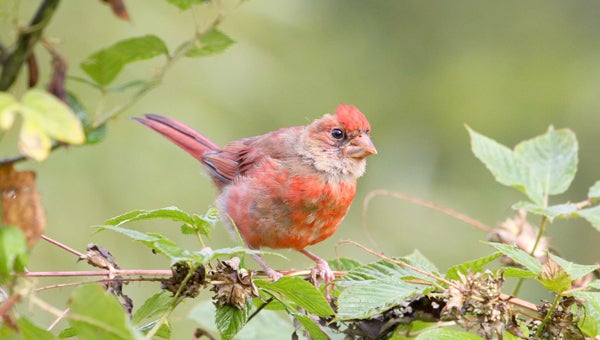Molting cardinals surprise some bird enthusiasts
Published 8:56 am Monday, September 12, 2011
Bald cardinals with somewhat reptilian bare black heads – who ever would see such a thing?
Well, welcome to the heat of mid-summer and with it the reports of bald-headed northern cardinals, blue jays and even common grackles.
Every year I get emails and phone calls describing these mutant-looking birds that aside from their featherless heads otherwise look exactly like the aforementioned species. I must admit that the first time I saw one of these somewhat bizarre looking birds I thought it must have been very sick.
Most birds molt their feathers twice a year, replacing all or most of their feathers over a period of a few weeks to a month or so. This is easily seen in our summer resident scarlet tanagers. The males are brilliantly colored red with black wings and tail when they arrive in the spring. By the time late summer rolls around the males’ red feathers are slowly being replaced by green.
The birds retain this green plumage through the winter months on their wintering grounds, only regaining their red coloration before they begin to again move north in our spring.
It is the same with indigo buntings.
The males lose their bright blue plumage in September and molt to a very even brown before their southbound migration. They then superficially resemble the plainer females and immature birds, but they do retain some blue feathers in their wings and tail.
As in many species, male indigos will molt back into their spring finery before they return north to breed. Even during their spring migration some of the males appear in a rather unusual combination of brown and blue feathers.
Here in the mountains of Western North Carolina, many of our resident birds also molt in late summer, usually after they have finished their breeding season.
With many species, such as tufted titmice, Carolina wrens or Carolina chickadees, it’s not very noticeable, but with others the results can look very peculiar indeed and this is especially noticeable in cardinals and blue jays.
Annual molting may indeed be part of the “baldness syndrome,” but it also may be a result of an infestation of feather mites or lice. It seems as if immature birds undergoing their first molt may be just as likely as adults to undergo this feather loss and we don’t really understand why they lose all of their head feathers at one time.
Staggered feather replacement is the normal molting pattern and this is where those mites may play a part resulting in the complete loss of the bird’s head feathers. Some recent research has suggested that it could even be a result of a nutritional or environmental factor but I am not so sure about this. To be honest, no one knows for sure, as the condition has not been well studied.
Fortunately for the birds, new head feathers do grow in within a few weeks and the birds look less and less reptilian, obviously none the worse for wear after their summer ordeal.
Simon Thompson has lived in WNC for the past 16 years. He owns and operates his own birding tour company, Ventures Birding Tours – www.birdventures.com. He and Chris also own and operate the Asheville Wild Birds Unlimited Store. For more information on any of the birding activities in the area, drop by the store or check his website at www.ashevillewbu.com.






